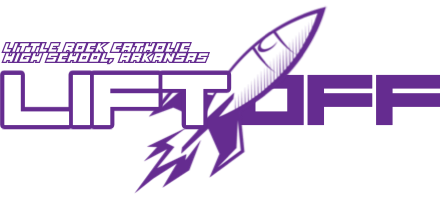Broadcasting Process

Anything worth doing isn’t easy and takes time. The broadcast team of Catholic High know this. They know how to do things well when time isn’t even on their side.
Senior Matthew Gleason said, “The video making process generally takes about three weeks. The first week we brainstorm ideas with a drawing board in groups, then refine them into what we want and write out guidelines and scripts for the videos.
“The second week we film it. Everything takes several takes to get right so filming can take a while, but we also don’t have very much time to do the filming so that creates a time issue. Sometimes we improv if we think it’s better than the script, usually only in a couple scenes per video and it works out well.
“The third week is editing, and it usually takes the longest. We film with physical tapes, a lot like cassettes, and we have to dump the tapes in real time into the computer. That means however long the film is, it takes that long to upload, so it can be time-consuming. Also, the labels are disorganized so we have to hunt for the right tape sometimes. We use Adobe Final Cut to edit the videos which is good software, but we also have to do some filming during the editing week because we’ll notice we left something out or want to add something in to the video.” Said Gleason.
Sophomore Toby Steinkamp said, “I mostly do editing because we don’t get to do as much filming as I’d like due to the environment we’re in with the timing and the lack of materials. I joined broadcast because it was a way for me to write and entertain people, and I like making videos.
“The process we have is good for now but we need to make some changes. We don’t have too many failures, but when we do it’s for one of two reasons. Either it’s a human error, which is easy to fix because we can just go through and make sure all the equipment is set up right, or it’s a material failure. Those are much harder to correct because we have to individually make sure each piece of equipment is working properly,” said Steinkamp.
Senior Beckett McFarland said, “I joined at the end of last year because I want to go into the film industry and become an editor when I graduate. Broadcast was the logical thing to do to prepare for that.
“Mostly our errors come from equipment breaking. It’s been here since the broadcast studio was built in 2010. Sometimes people step on wires and they unplug, sometimes we drop something, but usually stuff just stops working by itself. The other day we couldn’t get the sound to work, and we checked everything and couldn’t find what was wrong, until I figured out we just had to hold this one button down really hard and it would work, so we just put tape over it and it’s fine now.
“I’m really glad I joined broadcast. It’s been a positive experience for me. I’ve learned a lot about what it’s like to actually write, shoot, and edit film, so I feel that it’s prepared me very well for going to film school or just working on a set,” said McFarland.







